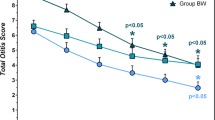Abstract
The purpose of this study was to evaluate the effectiveness of 5% trichloroacetic acid (TCA) in the treatment of acute external otitis (AEO) in comparison with a standard clinical treatment. All patients who consecutively presented in our emergencies with AEO during the summer months of the previous year were included in the study. They were randomly divided into two groups: the study group included 117 patients treated with TCA and the control group included 98 patients treated with ear drops containing antibiotic and corticosteroid. Occasionally, an antibiotic was administered orally for 7 days, in severe cases of AEO. All patients were evaluated on days 1, 3, 5, 7 and 10, whereas another review appointment was given 20 days later. Outcome measures included evaluation of efficacy using a six-step infection score and tolerability by visual analogue scale. Additionally, adverse reactions, complications and recurrencies were recorded. Treatment was successful for all patients of the study group, whereas 8 failures were found in the control group. The infection score improved faster in the study group than in the control group, resulting in an earlier clinical cure (mean 4.1 and 8.6 days, respectively). Tolerability was significantly better in the study group, on all points of evaluation. Complications and adverse reactions were minimal on both groups. Our results show that TCA is a very effective and nontoxic agent for the treatment of AEO. Rapid pain relief and prevention of recurrencies are its main advantages.


Similar content being viewed by others
References
Meyerhoff WL, Caruso VG (1991) Trauma and infections of the external ear. In: Paparella MM, Shumrick DA, Gluckman JL, Meyerhoff WL (eds) Otolaryngology, vol II. Otology and neuro-otology, 3rd edn. Saunders, Philadelphia, pp 1227–1235
Roland PS, Stroman DW (2002) Microbiology of acute otitis externa. Laryngoscope 112(7 Pt 1):1166–1177
Hwang JH, Chu CK, Liu TC (2002) Changes in bacteriology of discharging ears. J Laryngol Otol 116:686–689
Mugliston T, O’Donoghue G (1985) Otomycosis—a continuing problem. J Laryngol Otol 99:327–333
Agius AM, Pickles JM, Burch KL (1992) A prospective study of otitis externa. Clin Otolaryngol Allied Sci 17:150–154
Pond F, McCarty D, O’Leary S (2002) Randomized trial on the treatment of oedematous acute otitis externa using ear wicks or ribbon gauze: clinical outcome and cost. J Laryngol Otol 116:415–419
van Hasselt P, Gudde H (2004) Randomized controlled trial on the treatment of otitis externa with one percent silver nitrate gel. J Laryngol Otol 118:93–96
Neher A, Nagl M, Appenroth E, Gstottner M, Wischatta M, Reisigl F, Schindler M, Ulmer H, Stephan K (2004) Acute otitis externa: efficacy and tolerability of N-chlorotaurine, a novel endogenous antiseptic agent. Laryngoscope 114:850–854
Coleman WP 3rd, Futrell JM (1994) The glycolic acid trichloroacetic acid peel. J Dermatol Surg Oncol 20:76–80
Wiest L (2004) Chemical peels in aesthetic dermatology. Hautarzt 55:611–620
Russell JD, Donnelly M, McShane DP, Alun-Jones T, Walsh M (1993) What causes acute otitis externa? J Laryngol Otol 107:898–901
Huskisson EC (1974) Measurement of pain. Lancet 2(7889):1127–1131
Emgard P, Hellstrom S (2001) A topical steroid without an antibiotic cures external otitis efficiently: a study in an animal model. Eur Arch Otorhinolaryngol 258:287–291
Emgard P, Hellstrom S (1997) An animal model for external otitis. Eur Arch Otorhinolaryngol 254:115–119
Tsikoudas A, Jasser P, England RJ (2002) Are topical antibiotics necessary in the management of otitis externa? Clin Otolaryngol Allied Sci 27:260–262
Goldenberg D, Golz A, Netzer A, Joachims HZ (2002) The use of otic powder in the treatment of acute external otitis. Am J Otolaryngol 23:142–147
Krypel L (2000) Otic disorders. Chapter 24. In: Allen LV jr., Berardi RR, DeSimone E II (eds) Handbook of nonprescription drugs, 12th edn. APhA Publication Sales, Williston VT, pp 541–557
Kashiwamura M, Chida E, Matsumura M, Nakamaru Y, Suda N, Terayama Y, Fukuda S (2004) The efficacy of Burow’s solution as an ear preparation for the treatment of chronic ear infections. Otol Neurotol 25:9–13
Fields M (2002) Otitis externa. N Z Fam Physician 29:108–111
Smathers CR (1977) Chemical treatment of external otitis. South Med J 70:543–545
Fabricant ND (1964) The pH of the throat, nose and ear. Eye Ear Nose Throat Mon 43:60
Martinez Devesa P, Willis CM, Capper JW (2003) External auditory canal pH in chronic otitis externa. Clin Otolaryngol Allied Sci 28:320–324
Sellars SL (1969) The closure of tympanic membrane perforations by cautery—a reappraisal. J Laryngol Otol 83:487–491
Shi SR, Cote C, Kalra KL, Taylor CR, Tandon AK (1992) A technique for retrieving antigens in formalin-fixed, routinely acid-decalcified, celloidin-embedded human temporal bone sections for immunohistochemistry. J Histochem Cytochem 40:787–792
Resnik SS, Resnik BI (1995) Complications of chemical peeling. Dermatol Clin 13:309–312
Jinn TH, Kim PD, Russell PT, Church CA, John EO, Jung TT (2001) Determination of ototoxicity of common otic drops using isolated cochlear outer hair cells. Laryngoscope 111:2105–2108
Pickett BP, Shinn JB, Smith MF (1997) Ear drop ototoxicity: reality or myth? Am J Otol 18:782–791
Hurst WB (2001) Outcome of 22 cases of perforated tympanic membrane caused by otomycosis. J Laryngol Otol 115:879–880
Bojrab DI, Bruderly T, Abdulrazzak Y (1996) Otitis externa. Otolaryng Clin North Am 29:761–782
Author information
Authors and Affiliations
Corresponding author
Rights and permissions
About this article
Cite this article
Kantas, I., Balatsouras, D.G., Vafiadis, M. et al. The use of trichloroacetic acid in the treatment of acute external otitis. Eur Arch Otorhinolaryngol 264, 9–14 (2007). https://doi.org/10.1007/s00405-006-0145-4
Received:
Accepted:
Published:
Issue Date:
DOI: https://doi.org/10.1007/s00405-006-0145-4




